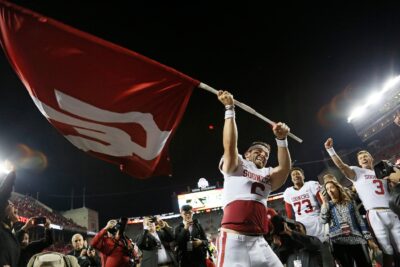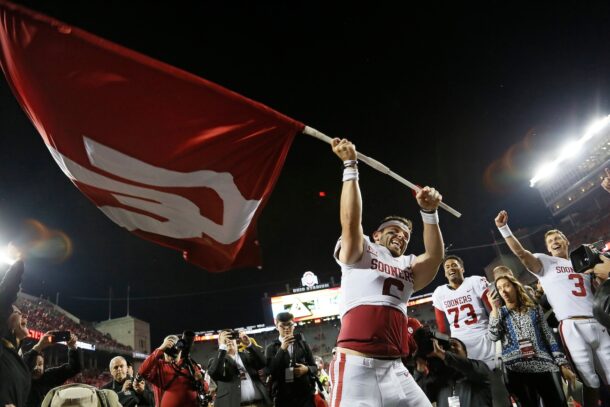
Does LSU have the right players in place to make Matt Canada’s versatile system work?
By Gary Laney
Published:
BATON ROUGE, La. — LSU has the guy it wants to modernize its offense in Matt Canada, who was introduced as offensive coordinator on Wednesday.
And we’re sure you’ve been inundated with stories about who Canada is and what he brings to LSU.
But how about this question: What is the new LSU offensive coordinator getting himself into in Baton Rouge?
As big as this hire was for Ed Orgeron and LSU, it’s huge for Canada’s career trajectory. If he manages to make LSU’s offense a prolific force, he’s head coaching material. But does LSU have what it takes to get him where he wants to go?
Short term, we know he should have a pretty good offense next year with Derrius Guice, Danny Etling and some veteran receivers and offensive linemen. Long term, we know what he’ll work with. LSU’s in a talent rich state and he should be able to get players. We’ve heard it all before.
But here’s the catch: For the level of coordinator LSU is after — including Canada — the long-term can be seen as irrelevant, something that comes for a coordinator in scenarios that are less than ideal. The ultimate goal is to knock it out of the park for the next few years and parlay that into the next career step.
Like a head coaching gig or perhaps an NFL job.
So it’s about what’s there now and what will be there in the next couple of years.
So let’s explore it, position-by-position, with the classes representing where the player is in the 2016 season.
Quarterback
Who’s back: Starter Danny Etling (Jr.), 2015 starter Brandon Harris (Jr.), RS-Fr. Brandon McMillan, Fr. Lindsey Scott.
What’s coming: Maybe 4-star recruit Lowell Narcisse, maybe 4-star recruit Myles Brennan.
https://twitter.com/mylesbrennan12/status/809197152320811008
Outlook: The most interesting question for LSU going forward is what to do at this position. Etling and Brennan (if he comes, and it’s looking better) are pro-style guys. The others are dual-threat guys. What kind of quarterback does he want?
“The best quarterback,” Canada said.
What kind of quarterback is best?
Judging from his resume, that answer can change depending on what candidate meshes best with the players around him and which one is better at his strengths.
For example, if Canada likes the receivers and wants the quarterback who can get the ball to them best, perhaps Etling will keep the job. But what if Canada likes the potential interaction a runner like Scott has with Guice on option runs? Then, perhaps, he can go that direction and LSU will look more like Auburn.
Canada has succeeded with quarterbacks who were run-pass threats, efficient throwers and guys who were both.
Whatever the case, this is the position he will largely be judged by, at least by the public. LSU has had well-documented issues at the position that led to the firing of Les Miles as head coach.
Basically, Canada is at LSU because LSU has not been good at this position.
Not only has LSU not had great quarterback play, it also has an identity crisis at the position, caught between dual-threat guys and pro-style specialists. So Canada’s approach might make some LSU fans shudder — they feel as though Miles would never commit to a style — but the difference?
Canada has had success with all types of quarterbacks.
Running back
Who’s back: Starter Derrius Guice (So.), Jr. Darrel Williams, So. Nick Brossette, RS-Fr. Lanard Fournette, Starting FB J.D. Moore, So. Bry’Kiethon Mouton, So. David Ducre.
Who’s coming: 3-star recruit Clyde Edwards-Helaire, 3-star FB recruit Tory Carter.
Outlook: This looks like the never-ending position of strength for LSU, which has moved seamlessly in recent years from Stevan Ridley to Spencer Ware, Jeremy Hill, Alfred Blue, Kenny Hilliard, then to Leonard Fournette and Guice.

Considering that the last five names on the list are all Louisiana products, this could go on forever, right?
Well, maybe not. Guice has a year left in him before he will likely bolt for the NFL after his junior season. After that, the pickings start to get more slim. LSU had no running backs in its 2016 recruiting class after it was decided Devin White would play linebacker. That’s not likely to change as LSU’s lack of numbers at linebacker – the Tigers are desperately still looking for impact players at that position in the 2017 class – will probably necessitate that White remains on defense.
That leaves LSU a year away from being very thin at the position. Brossette was highly regarded out of high school, but has been the odd man out of the rotation with injuries playing a major role. Lanard Fournette is not considered to be in the same class as his more famous older brother.
So, like quarterback, finishing strong with the 2017 class will be huge for the Tigers beyond the 2017 season. The Tigers appear all-in on 5-star Mississippi prospect Cam Akers. Where does LSU go if Akers goes elsewhere? That could be an issue. In-state, 4-star prospect Travis Etienne is out there, but LSU doesn’t appear to be on the radar.
One would think with its recent history of success with backs, LSU should land a top prospect in this class. But if the Tigers don’t and only have the more 3-star Helaire in the class, they could have an issue in 2018.
The LSU fullbacks can breathe a sigh of relief. Fullbacks were used to great effect by Canada at Pitt, where George Aston scored nine touchdowns (five rushing, four receiving) for the Panthers. With three solid fullbacks returning, LSU should be in good shape there for a while.
Wide Receiver/Tight End
Who’s back: Starters Malachi Dupre (Jr.) and D.J. Chark (Jr.); Jr. Russell Gage, Fr. Dee Anderson, Fr. Stephen Sullivan, Fr. Drake Davis, Fr. Derrick Dillon, So. Jazz Ferguson. Tight ends: So. Foster Moreau, So. Jacory Washington, Fr. Jamal Pettigrew.
Who’s coming: 4-star recruit Mannie Netherly.
Outlook: LSU should be fine here for the next few years as the talented 2016 signing class develops. Dupre will be a senior, if he returns, and will team with Chark and Gage to give the Tigers experience in 2017, but all three will be seniors.
One interesting thing to note is Canada loves using receivers on misdirection plays and on the jet sweep. That should be right up the alley for Chark, who has had some moments running those plays. But Canada used those plays frequently at Pitt, with receiver Quadree Henderson rushing for 555 yards and averaging 10 yards per run.
He is actually more productive on the jet sweep than he was as a receiver, where he has 241 yards receiving.
In 2018, Canada will have a young quarterback and young receivers to deal with. It would help if the Tigers can land what some are calling the state’s best prospect, 4-star wide receiver Devonta Smith.
At tight end, LSU loses two of its three productive tight ends, but Moreau gives the Tigers a solid option for a couple of years. LSU probably needs to bring in a tight end in this recruiting class.
Like fullback, Canada is not scared to use tight ends either.
“So we’re going to do what we have to do to get our players on the field,” he said. “If we have a multitude of tight ends, you’ll probably see more of those guys on the field. If we have great receivers you’re going to see them on the field more.”
Offensive line
Who’s back: Starters — LT K.J. Malone (So.), LG Will Clapp (So.), RT Toby Weathersby (Jr.), Utility Maea Teuhema (Jr.). Reserves — T: Fr. George Brown, Fr. Jakori Savage, G: So. Garrett Brumfield, Fr. Adrian Magee, Fr. Donavaughn Campbell. C: Jr. Andy Dodd, Fr. Lloyd Cushenberry.
Who’s coming: 4-star T Austin Deculus, 4-star G Edward Ingram, 4-star G Saahdiq Charles, 3-star T Seth Stewart.
Outlook: The offense should be fine here. It’s just a matter of getting the pieces in the right places.
Malone, Clapp, Weathersby and Teuhema are all juniors next year and at least a couple of them should be senior starters in 2018 (we’re assuming one or more may progress to NFL Draft status). Dodd might be a natural to start at center (or, Clapp can be moved there), so there would be some rebuilding in 2018, but nothing drastic.
LSU suffered a little bit of a blow with the loss of Chidi Okeke, the once highly-regarded tackle prospect who opted to transfer. But Okeke had not panned out, so maybe it’s better that he make room for what’s looking to be a deep offensive line recruiting class.
Overall
Here’s the thing about Canada: Part of the reason he looks so versatile on paper is he keeps bouncing around. He had a 4-year stay as offensive coordinator at Indiana from 2007-10, but since then he’s had three 1-year stops (Northern Illinois, Wisconsin and Pitt) and one 3-year stop at N.C. State.
Maybe he’s good at adapting because he’s had a lot of practice, for one reason or another. So the key is, we’ll probably get a better idea of what Canada’s ideal offense looks like the longer he stays and influences the personnel LSU recruits. This is something we’ll really learn in years three or four.
But here’s the catch: If the Canada thing really works the way LSU hopes, he won’t be around that long. He was already in the mix for head coaching jobs this offseason (he was interviewed at Western Kentucky). If the Tigers become an explosive offense under his mentoring in the next couple of years, he’ll have to make his biggest adjustment yet: To being a head coach.
For LSU, that should be fine. It has the money to go out and get another big name. If Cameron (and, for that matter, defensive coordinator Dave Aranda) take career steps through success as LSU coordinators, that would allow Orgeron to attract more coordinator talent to Baton Rouge.







